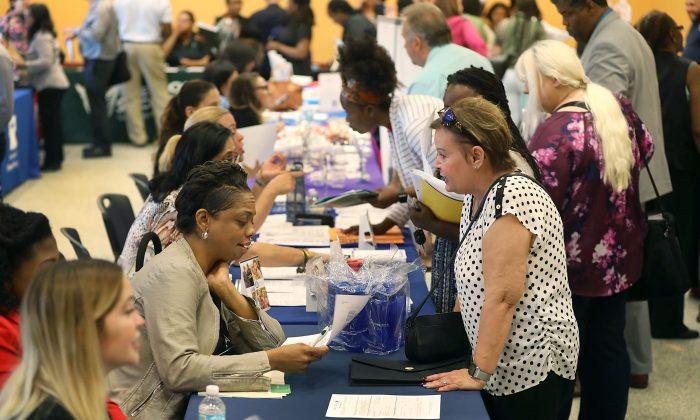U.S. job growth has been the strongest in middle- and high-paying industries in the past nearly two years, reversing the previous trend of an economy that grew the most in its lower-paying tier.
The trend reached its starkest point in late 2018, when jobs in high-paying industries reached a growth of some 2.3 percent year-over-year. Those in middle-paying industries recorded growth of about 2.7 percent, while in low-wage industries, jobs expanded by about 1.7 percent.
That contrasts with late 2016, when low-paying industries’ payrolls grew by about 2 percent, while jobs in the high- and middle-paying industries grew by some 1.8 percent and 1.7 percent, respectively.
In recent months, the job market appears to have cooled, with middle- and high-paying industries still showing a yearly job growth of about 2 percent, and the low-paying industries growing by some 1.3 percent.
The 3.2 percent wage growth in July (year-over-year) hides another shift: While in early 2018, it was high-wage industries with the fastest salary growth (about 3 percent), for the past year, annual growth has been strongest in low-wage industries, currently about 4.7 percent.
Unemployment
The economy added 164,000 jobs in July, keeping the unemployment rate at 3.7 percent, near a 50-year low.Amid employers’ complaints of a skilled worker shortage, the Trump administration has been urging companies to offer apprenticeships and training as part of its “Pledge to America’s Workers” initiative.
China Tariffs
The strength of the labor market has allowed President Donald Trump to escalate tariffs on China, in a bid to force the geopolitical rival into dropping rogue trade practices. Trump has meanwhile called on the Federal Reserve to lower interest rates, citing mild inflation and monetary easing by the European Union.With the trade talks ongoing, many companies have decided to move their operations outside of China to dodge the increasing tariffs. Lower interest rates would give them cheaper credit to fund the transition.
The central bank has so far offered one quarter-point cut, effective in September.
“I don’t think it is realistic for the Fed to respond to each threat and counter-threat in a tit-for-tat trade war,” said St. Louis Federal Reserve President James Bullard, referring to the current situation as a “Pandora’s box” that will be difficult for the United States, China, and other countries to resolve any time soon.
“We are taking a one-time increase in trade uncertainty on board,” Bullard said in comments to the National Economists Club that indicate a more patient approach to additional rate cuts than he has previously shown.
China appears to be trying to wait Trump out, pinning its hopes on getting more lenient treatment in the future if Trump loses the 2020 election. Trump warned, however, the conditions of any potential deal would be even less advantageous to China if it waits until he’s reelected.





